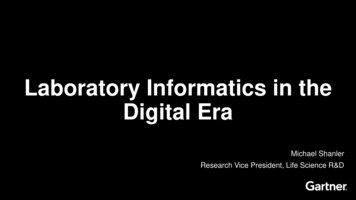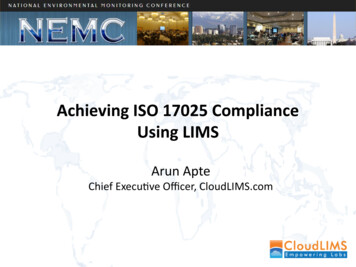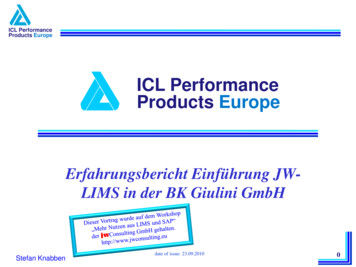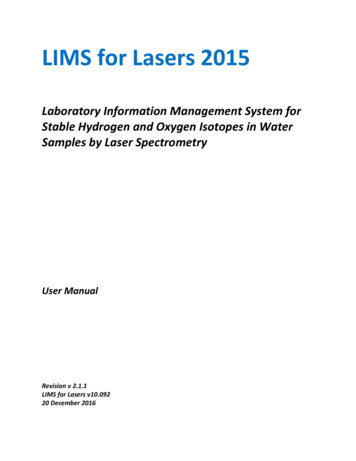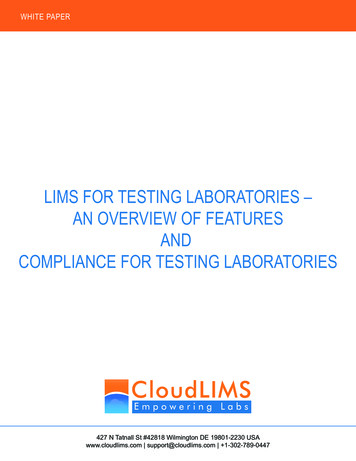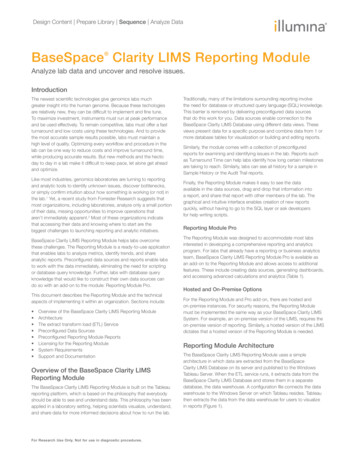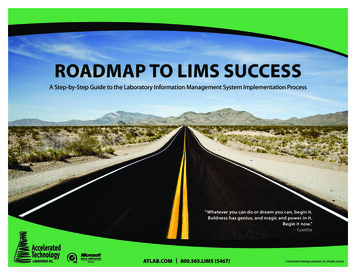
Transcription
ROADMAP TO LIMS SUCCESSA Step-by-Step Guide to the Laboratory Information Management System Implementation Process“Whatever you can do or dream you can, begin it.Boldness has genius, and magic and power in it.Begin it now.”– GoetheATLAB.COM 800.565.LIMS (5467) Accelerated Technology Laboratories, Inc. All rights reserved.
IONENTAONCONUFIGSPECIATL’s Implementation ProcessFREORCYESATURNGLEMTIRITE FIC AST TIONINGFEINIIMPVEMPOSUPTR AON TIMEON BUDGETISO 9001PEQUALITYWORKINGPROCESSTEIATSCORTINITRESP QUEC IREMIFICAT ENTIONSPLOYSPRS&YSIAL INGAN ANNPLDEADEINECTRPGDEFJEUVE)OMENTLIOG(YSSE
PurposeATL’s process for implementing our LIMS software and solutions is the culmination of twodecades’ experience working with clients of various sizes in numerous markets and industries.Over the course, we’ve leveraged guidance from our ISO Certified Quality ManagementSystem and worked to continuously perfect this process and maintain best practices. We inviteyou to benefit from our experience.This guide is intended to beused alongside various ATLimplementation tools: Templates Checklists Gantt Chart Dashboard Training MaterialsImplementing a new LIMS is a team project: it is important that partners,participants and engineers work closely together in order to successfullyaccomplish the mission. This guide is designed as a workbook: it is brokendown into four main sections with eight subsections that walk step-by-stepthrough the process — from defining project scope through final deployment,including planning, configuration and training. There are places to take notesand document action items throughout.Think of this guide as a road map that will prepare you for the various stages of LIMSimplementation. If you have any questions, please contact your ATL representative.Let’s get started!—The Accelerated Technology Laboratories Implementation TeamTABLE OF CONTENTS:Define Project Scope . p5Specify Core Features . p13Implementation . p213 Accelerated Technology Laboratories, Inc. All rights reserved.Deployment . p25“Alone we can do so little;together we can do so much.“— Helen Keller
ATL ADVANTAGE PLAN: A ROADMAP TO SUCCESSDEFINEPROJECT SCOPEINITIATIONDetermineneed for a LIMSand commit toprojectANALYSIS &PLANNINGSPECIFY CORESYSTEM FEATURESREQUIREMENTSPECIFICATIONSDistribute Needs Review definedAssessment (NA) project scopesurveyRequirementsAssemble team Conduct a Needs listAssessment (NA)Ensure resourcesHistorical dataare availableAnalyze surveymigrationresultsDocument needsStatic dataConduct workflow migrationCategorize needs analysisInstrumentPrioritize needs Interviews team integrationmembersCompleteReporting needsrisk analysisConductand EDDslaboratory tourBudget andThird partytimingReview NA results softwareand reportintegrationFinal review ofrequirementsPLANNING TOOLS:Checklists, Gantt chart, dashboard and survey** if Needs Assessment purchasedDefineconfiguration &customizationsIMPLEMENTATIONCONFIGURATION VERIFICATIONTESTINGPopulate statictable data andQuality controlconfirm installchecksDefine customcaptionsStatic dataTRAININGDEPLOYMENT“GO LIVE”SUPPORTUPGRADESOn site classroom Live technicaltrainingassistanceNew featuresand functionsOn the jobtrainingRegulatedenvironmentCheck accuracyExplanation offunctionalityWeb and resource KnowledgebaseSet up users andbased DVDCheckspellingWhite paperspermissionsTraining manualsValidatesetupFAQsSet up workflowsVideo tutorialsWorkflows&User forumSet upe-signaturesQuickstart Guidee-signaturesElectronicallyCalculations,Boot Campsubmit anSet up controllimits & chartingincidentlimitsParallel testingWebinarsDefine calculations Reports, parsers& SOPsConfirm FRSs(FunctionalRequirementSpecifications)PLANNING TOOLS:PLANNING TOOLS:Template, Functional Requirement Specifications Admin and end user training manuals,resource DVDRe-validationrequired?NewdocumentationTraining on uggestion boxfor new featuresPLANNING TOOLS:www.atlab.com Support
DEFINE PROJECT SCOPEScope definition is the first and most important phase of a LIMS implementation project because itdefines the time required as well as total project cost. Project managers must commit to and protect theoriginal scope in order to avoid the dangers associated with creep. There are two placesA project can be thought of as ascope is defined: high level (laboratory needs), and low level (business requirements).box. High level scope defines the Together these define the overall project.walls of the box and separateswhat is relevant and related toHIGH LEVEL SCOPEthe project from everythingDefine deliverables: often presented in Excel, this helps define the overall project scope.that is not relevant.Define boundaries: helps separate what is in scope vs. what is not. i.e. This project willaffect US operations only, all other operations are out of scope;’ or ‘This software will bedeployed in manufacturing and laboratory divisions, all other divisions are out of scope.NOTESHIGH LEVEL SCOPEOnce the project starts, there generally aren’t many requests to change boundariesand deliverables. Instead, most changes are within business requirements, which helpdefine the details of the project.LOW LEVEL SCOPEProduct requirements (features): define the characteristics of the deliverables i.e. Ifbuilding a house, most of the requirements would be product based like 2x4s, sheetrock,nails, rooms, doors, windows, etc. When implementing a LIMS, requirements may include unique,automatically-generated numbers, electronic signatures, QC charting, full audit trail, and much more.Process requirements (functions): define how people interact with the LIMS and how the LIMS interactswith other software such as a Supervisory Control and Data Acquisition (SCADA) system. For example,discussing how data is moved and transactions flow from one point to another describes processrequirements. Describing transaction requirements is more process-oriented, such as how billing moves fromorders to invoicing to accounts receivable, or how to look up a status, manually update an invoice and print areport on demand.Although the project manager will be intimately familiar with the project, it is also important for keystakeholders to understand overall project scope and how the key pieces fit together.For additional information on implementing a LIMS, see the article, “Effectively Defining LIMSSystem Requirements: Launching a Successful Laboratory Automation Project” publishedin 2006 in Scientific Computing Journal. This paper discusses the relationship betweenperformance, cost and time as they relate to the scope of the LIMS project.5 Accelerated Technology Laboratories, Inc. All rights reserved.LOW LEVEL SCOPE
DEFINE PROJECT SCOPE: INITIATIONDetermine need for a LIMS and commit to projectNOTESThe first step in this process is to identify the reasons a LIMS is needed. Once the preliminary due diligencehas been completed and it is determined that with an investment in a new LIMS, the business will remaincompetitive and grow with a fast return on investment (ROI), key stakeholdersOnce the original scope is identified,will move forward on the project.only then should new requirementsIt is critical that top management is brought in at this point to support the effortbe considered. Within the ATL projectmanagement plan, these items areand the team 100 percent. Management must allocate time to the team tocollected and documented for Phasecomplete the project, be prepared to provide additional resources required forII consideration; this is just one way tounanticipated reasons, and carefully monitor the project to avoid scope creep. Ifmanage the risk of scope creep.scope increases, time and cost to complete the project will likely also increase.WHY DO WE NEED A LIMS?Assemble teamThe LIMS team is typically a multifunctional group of stakeholders that consists of several disciplines, includingScientists, Information Technology, and Management.It is important to include key system users for several reasons: Everyone has different needs, and compromises will need to be made: not everyone will get all he or she wants,but each person should have major needs met by the new system. It is much easier to implement a system in which there is user buy-in, rather than a system selected by apurchasing agent because it was offered at a lower cost.In selecting team members, thefollowing are typically included: Quality Assurance Manager Laboratory or Plant Manager IT resource Key end users from departments The Quality Assurance Manager is usually familiar with the organization’s mostcritical needs, as well as regulatory requirements for their industry/customers. The LIMS project manager, (PM) typically a person with the most projectmanagement experience, will serve as point of contact with the ATL PM. Management will have very specific requirements in terms of tools such asspecific reports, i.e. Chain of Custody, TAT (Turn Around Time), production andworkload reports, etc. The management team may also be concerned with tracking costs, also if there is a needto integrate the LIMS with an accounting package.(chemistry, microbiology, toxicology, etc.)ATL’s LIMS products can be integrated with most common software packages such asQuickBooks and Peachtree, JD Edwards, Great Plains, and more6 Accelerated Technology Laboratories, Inc. All rights reserved.TEAM MEMBERS
DEFINE PROJECT SCOPE: INITIATIONEnsure resources are availableVarious phases of the project will require dedicated time from various team members. The ATL Ganttchart breaks down resource requirements along with typical time estimates. ATLengineers will also have dedicated times to complete project tasks; therefore, it is criticalthe entire team shares a close working relationship. There will be many instances wherea client team member is asked to complete a task so that an ATL team member cancomplete another task. ie Completion of the pre-installation checklist and static table datatemplate is important so the ATL engineers can import the data, including tests, methods,parameters, SOPs, sites, clients, contact information and related data.ATL engineers have found that these tasks typically require two weeks to complete and are dividedamong key LIMS project team stakeholders (fill in the pre-install checklist and static table template).This does not include any result data that may be migrated from a historical LIMS or Excel sheet, whichrequires a detailed technical review, plus time and cost analysis.Document needsEach person on the team may have a slightly different vision for, and expectations of, the LIMS, so itis vital for the project manager to gather all high-level needs or requirements up front to ensure anyconflicts are addressed early and quickly. During this task, needs should be discussed at a very highlevel. For example, one issue may be the need for improved organization of the laboratory samples to reducethe number lost. This need could be met by implementing a barcoded labeling and scanning solution, or itmay require additional refrigerator space. However, the project manager must simply gather needs, butnot jump to potential solutions; this will come during the analysis/planning phase.Prioritize needsThe project manager must monitor and manage the project to ensure adherence to initial needs,requirements or prioritization. Often requirements can be broken into three categories: must have,nice to have, and eventually needed or wanted. Other teams evaluate the financial returns (ROI)to determine how much time and money a feature would save, and if the savings are not above adollar threshold those items are dropped. ATL has created a number of tools to assist in this process:a ROI calculator, a project Gantt chart that outlines resources and time commitments, and a projectdashboard that lists all key deliverables along with their status. The dashboard is regularly updated(usually bi-weekly) and emailed to the team following progress meetings.7 Accelerated Technology Laboratories, Inc. All rights reserved.NOTESLIST RESOURCES REQUIREDLIST AND PRIORITIZE NEEDS
DEFINE PROJECT SCOPE: INITIATIONCategorize needsIt is often easier to break into sections the requirements that deal with various high-level businessfunctions. This also allows the project manager to view the costs for each section,Break needs into high-level functions,as funds often come from different pools of resources that must be tracked.for example: IT requirements may include anew server, software or increasedComplete risk analysisbandwidthOne of the project manager’s responsibilities is to examine all the things that The laboratory may need barcodescanners and new label printerscould potentially derail a project, including scope creep and jumping ahead to Accounting may need to integratefuture phases before completing requirements for previous phases. It is helpfulthe LIMS with accounting softwareto list these items and document potential solutions, a process known as risk Specific reporting requirementsmitigation.need to be documented and sharedwith the ATL project managerTo reduce scope creep, the project manager may need to push new items tofuture phases because they don’t fit within the original project scope and wouldincrease cost and time. Often these additional needs are sound ideas or important requirements, sothey should be documented and re-evaluated after initial system implementation.NOTESHIGH LEVEL FUNCTION NEEDSPOTENTIAL RISKWorking on phases out of sequence usually results in additional costs, time, resources and delays. Forexample, many people recognize that reports are critical and want to work on them first. However, untilthe database is fully configured, any work on reports would most likely require re-work later in responseto changes within the database.Budget and timingOnce scope is clearly defined, the time and budget requirements to complete a project should beestablished. If there is confusion regarding laboratory needs versus wants, or if the team doesn’t share aunited vision, it is a good idea to conduct a Needs Assessment (NA). This can be done internally or withan external consultant, and the end goal is a clear understanding of where a laboratory needs to be inorder to meet regulatory compliance goals and maintain a competitive advantage.ATL offers on-site Needs Assessment, utilizing a powerful toolset and subject matter experts to understand the current state of a laboratory.Surveys, interviews, and observations are output in a final Needs Assessment report.8 Accelerated Technology Laboratories, Inc. All rights reserved.BUDGET AND TIMING
DEFINE PROJECT SCOPE: ANALYSIS & PLANNINGDistribute Needs Assessment (NA) surveyA Needs Assessment — a systematic process for determining and addressing needs or gaps between anorganization’s current condition versus its desired state — is an important part of the planning process.ATL has created a series of NA surveys specific to various industry segments, which include universalquestions and questions specific to the needs and regulations in that industry. This a valuable tool toprovide a better understanding of the organization’s current state and set of perceptions. A copy of thecompleted survey is included in the final NA report, and this document is sent to clients electronically inadvance of an on site assessment.Conduct Needs AssessmentThe discrepancy between current and aspirational states must be measured in order to appropriatelydefine the need, which can be: a desire to improve current performance, efficiency or accuracy; correcta deficiency; or in response to a regulatory requirement. Gathering appropriate and sufficient dataensures that the solution developed will address the group’s needs and wants. By clearly identifyingchallenges, finite resources can be directed towards developing and implementing a feasible solution.Analyze survey resultsOnce the NA survey is completed, it is important to review the results as a group to ensure theresponses reflect shared goals. This session is conducted on site and often triggers more questionsand feedback on processes and business practices, which leads to a more complete understanding ofcurrent and potential challenges.Conduct workflow analysisAn ATL subject matter expert will take notes as the LIMS project manager details “a day in the life of asample,” as it moves through the laboratory. These notes are transformed into a flow diagram(s) for laterreview and discussion. During the needs assessment and implementation, an organization has multipleopportunities to examine how business is conducted and determine if ways that are more effective existto achieve goals.9 Accelerated Technology Laboratories, Inc. All rights reserved.“By failing to prepare, you arepreparing to fail.”— Benjamin Franklin
DEFINE PROJECT SCOPE: ANALYSIS & PLANNINGInterview team membersIn any project, it is critical that goals and expectations are clear to all members. In this step, an ATLsubject matter expert (an individual with five or more years of laboratory automation or hands-onexperience) interviews key stakeholders to understand needs, daily challenges and concerns. This is acritical step in the needs assessment, and information gathered will be included in the final report.Conduct laboratory tourATL team members tour a facility and leverage hands-on experience and an understanding oflaboratories and automation in order to identify improvements that can be made based on what hasbeen successfully implemented in similar laboratories. An additional advantage of on site observation isthe ability to identify potential project risks that may not be apparent from the outside.Review NA results and final reportOnce an ATL subject matter expert has completed the evaluation and collected survey responses andnotes, several days are spent condensing and summarizing findings. Those findings are then sharedwith an ATL needs assessment team for review and comments. The team reviews the data and adds anypertinent comments or recommendations to the final report, which is then presented to the client.Final review of requirementsThe assessment is a tool to validate the high-level needs previously identified by the team. Once theproject manager and team have reviewed the report, a meeting is scheduled with the ATL projectmanager to address questions and ideas resulting from the assessment. In many cases, LIMS needs andproject scope are adjusted.Suggested Reading:1. Christine Paszko, 2006.Effectively Defining LIMS System Requirements: Launching a SuccessfulLaboratory Automation Project. Scientific Computing pp 3-5.2. Christine Paszko, 2009.How Can a LIMS Needs Assessment Save the Laboratory Money. Scientific Computing pp 1-4.3. Alan Serrero, Ted Paczek and Christine Paszko, 2007.Laboratory Needs Assessment benefits LIMS Implementation. Waterworld pp18-20.10 Accelerated Technology Laboratories, Inc. All rights reserved.“Planning without action is futile,action without planning is fatal.“— Cornelius Fitchner
NOTES11 Accelerated Technology Laboratories, Inc. All rights reserved.
ATL ADVANTAGE PLAN: A ROADMAP TO SUCCESSDEFINEPROJECT SCOPEINITIATIONDetermineneed for a LIMSand commit toprojectANALYSIS/PLANNINGSPECIFY CORESYSTEM FEATURESREQUIREMENTSPECIFICATIONSDistribute Needs Review definedAssessment (NA) project scopesurveyRequirementsAssemble team Conduct a Needs listAssessment (NA)Ensure resourcesHistorical dataare availableAnalyze surveymigrationresultsDocument needsStatic dataConduct workflow migrationCategorize needs analysisInstrumentPrioritize needs Interviews team integrationmembersCompleteReporting needsrisk analysisConductand EDDslaboratory tourBudget andThird partytimingReview NA results softwareand reportintegrationFinal review ofrequirementsPLANNING TOOLS:Checklists, Gantt chart, dashboard and survey** if Needs Assessment purchasedDefineconfiguration &customizationsIMPLEMENTATIONCONFIGURATION VERIFICATIONTESTINGPopulate statictable data andQuality controlconfirm installchecksDefine customcaptionsStatic dataTRAININGDEPLOYMENT“GO LIVE”SUPPORTUPGRADESOn site classroom Live technicaltrainingassistanceNew featuresand functionsOn the jobtrainingRegulatedenvironmentCheck accuracyExplanation offunctionalityWeb and resource KnowledgebaseSet up users andbased DVDCheckspellingWhite paperspermissionsTraining manualsValidatesetupFAQsSet up workflowsVideo tutorialsWorkflows&User forumSet upe-signaturesQuickstart Guidee-signaturesElectronicallyCalculations,Boot Campsubmit anSet up controllimits & chartingincidentlimitsParallel testingWebinarDefine calculations Reports, parsers& SOPsscheduleConfirm FRSs(FunctionalRequirementSpecifications)PLANNING TOOLS:PLANNING TOOLS:Template, Functional Requirement Specifications Admin and end user training manuals,resource DVDRe-validationrequired?NewdocumentationTraining on uggestion boxfor new featuresPLANNING TOOLS:www.atlab.com Support
CORE SYSTEM FEATURES: REQUIREMENT SPECIFICATIONSThe second major phase of implementation deals with ensuring all aspects of the project have beendiscussed, considered, documented, planned and reviewed so that configurationPhase two is often the toughestcan commence. This is the most challenging phase because decisions must be madefor perfectionists who wantregarding features, functions, workflows, etc., and some may conflict — in which caseeverything flawless at eachproject stage, and before theythe project manager must assign priority.feel ready to go live.Identifying special requirements (instrument import, custom EDDs (Electronic DataDeliverables), reports, third party integration, etc.) is required at project initiation, indefining scope. Actually defining requirements occurs during this phase, whereasfinalization of the requirements occurs during the implementation phase.NOTESIDENTIFY SPECIAL REQUIREMENTSThe reality is that, as the business continues to evolve, unique requests crop up. Thebest strategy is to configure the database as soon as possible in order for paralleltesting to begin so that the laboratory can take full advantage of key requirements,while tweaking additional business processes to meet the required functionality. ALIMS is dynamic; there will constantly be new requirements and features that willevolve with the business.Review defined scopeThe initial phase of defining project scope will have produced a high level requirements/needsdocument. At this stage, it is very important to review and further refine the scope so it can be lockeddown and effectively communicated with all team members.Requirements listDuring this stage, requirements — a major part of project scope and core system functionality — arefurther defined. Many laboratories will begin with a list of common LIMS features and add or removefeatures and functions required to meet specific operational needs. The American Society for Testingand Materials (ASTM) offers a comprehensive yet generic list developed to cover different types oflaboratories that utilize LIMS.13 Accelerated Technology Laboratories, Inc. All rights reserved.SCOPE REFINEMENTS
CORE SYSTEM FEATURES: REQUIREMENT SPECIFICATIONSHistorical data migrationIn some cases, laboratories may wish to import historical data from a previous system, or Excel sheets, intothe new LIMS in order to review historical data and trends, or because they areData migration often requires therequired to import QC data.creation of queries and field mappingbecause of terminology variance. ForBecause data migration can be costly, often laboratories choose to leave old dataexample, in the previous system a fieldin the historical system to access only as needed.could be called “parameter,” and in thenew database it may be referred to as“analyte,” so it is important that the data Static data migrationfield be mapped one to another.Importing data (often a combination of Excel and paper forms) from a previousLIMS or data management system is known as static data migration. Data is typically comprised ofsite information, matrices, tests, methods, parameters, SOPs, clients, contact information, employeeinformation, etc. This is a good opportunity for the laboratory manager and IT team members to worktogether and correct errors or purge incorrect or obsolete static data.NOTESHISTORICAL AND STATIC DATABASE/FILE LOCATIONSINSTRUMENT INTEGRATION REQUIREMENTSInstrument integrationWhen implementing a new LIMS, one of the biggest time savings and quality improvements resultsfrom instrument integration. Importing data electronically rather than manually eliminates transcriptionerrors, and data can come straight from the instrument in many output formats, i.e. .XLS, .CSV, .TXT,XML, etc. Because the output from instruments can vary greatly, each instrument output file requiresconfiguration. ATL team members work with the client to document integration requirements withrespect to naming convention, output file formats and integration configuration, along with anyautomated or scheduled imports following data review.Reporting needs & EDDs (Electronic Data Deliverables)One major benefit of ATL’s LIMS is ease of reporting. In addition to several canned reports that comestandard with the system, users have the ability to modify canned reports as well as add their owncustom reports. Several canned EDDs in multiple output formats (i.e. XML and XLS) are included, andusers can create additional EDDs as desired.ATL offers courses on Report Writing to train users on best practices as well as how to create additional types. Visit our website to learn more.14 Accelerated Technology Laboratories, Inc. All rights reserved.PREFERRED EDD FORMATS
CORE SYSTEM FEATURES: REQUIREMENT SPECIFICATIONSThird party software integration (SAP, SCADA, etc.)If there is a need to share data with other enterprise systems, integration should be discussed in termsof what data is needed from which system. For example, does LIMS data need to be exported to an ERPsystem or SAP or does data from another enterprise system need to be imported into the LIMS?NOTESTHIRD PARTY INTEGRATION NEEDSNext, users must determine the frequency of data transfer, and whether it will be uni- or bi-directional.Another consideration is whether data imported is validated or requiresusers to validate and approve upon import. ATL’s LIMS products allow usersto configure the system to import or export data at configurable timessuch as hourly, daily, etc. Other options for integration include metrologydata, i.e. incubators, refrigerators, autoclaves, freezers, and other types ofenvironmental and instrument measurements.Define configuration and customizationsSystem configurations differ from customizations in that they do not involve any programming, i.e.data grid configuration, custom form or field captioning, and altering screen colors. Customizations areusually a competitive advantage of enterprise LIMS solutions because most businesses have uniquefeatures or proprietary processes that are not available in a commercial off the shelf (COTS) LIMS.Customizations are typically limited to less than 10% of the system, because most common features arealready included.The first step is to complete the ATL Customization Request Form, which is a non-technical form usedto document and define needed requirements. The ATL technical team uses this document to createthe Functional Requirements Specification (FRS), which serves as a blueprint for the engineer who willdevelop the new feature.Because ATL is an ISO certified firm, our quality assurance team must verify any customization. After thecustomization passes verification testing, it is documented and delivered to the client. Customizationsare typically addressed in further detail following initial system configuration: static table data mustbe configured first to provide the subject matter expert with information needed to complete therequirements document. For example, if instrument integration is going to be performed, it will be criticalto have all static table data configured so that the requirements document can indicate to which field theinstrument data will be imported.15 Accelerated Technology Laboratories, Inc. All rights reserved.FREQUENCY OF DATA TRANSFER
CORE SYSTEM FEATURES: CONFIGURATIONPopulate static table data and confirm installThe first major step in the configuration phase is populating static table data. This will serve as thefoundation for all future configuration steps, from creating functional requirement specifications (FRSs)for instrument integration to reporting. This frequently involves extracting data from a historical LIMSor Excel sheets, or even a paper-based system. This is an excellent time for theIt is also important to ensure that a back- laboratory team to clean up data such as test names, customer contacts, andup and recovery system is in place andother static table data information.the system has been tested before theThe second step, more of a system administrator task, is to ensure thatLIMS is put into production.installation was properly executed on a dedicated, secure server with adequateprocessing power, network connectivity, bandwidth and hard disk space — particularly if historical datawill be imported. In addition, the latest service packs of the database engine (SQL Server or Oracle) andLIMS software must also have been applied.NOTESIDENTIFY HISTORICAL STATIC DATA SOURCESDefine custom captionsATL’s system allows the utilization of terminology meaningful to a laboratory’s environment. This isaccomplished by allowing re-captioning of the form and field names. For example, if the laboratory callsa group of samples an Order, then the caption can be modified to reflect that. The LIMS admi
For additional information on implementing a LIMS, see the article, "Effectively Defining LIMS System Requirements: Launching a Successful Laboratory Automation Project" published in 2006 in Scientific Computing Journal. This paper discusses the relationship between performance, cost and time as they relate to the scope of the LIMS project.
